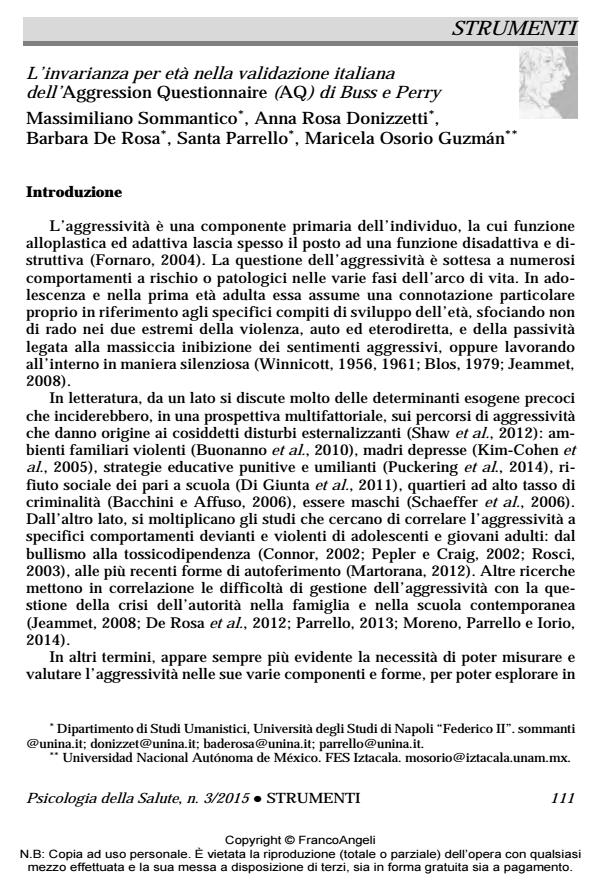Testing gender invariance of Italian version of Aggression Questionnaire (AQ) by Buss and Perry
Journal title PSICOLOGIA DELLA SALUTE
Author/s Massimiliano Sommantico, Anna Rosa Donizzetti, Barbara DeRosa, Santa Parrello, Guzman Maricela Osorio
Publishing Year 2015 Issue 2015/3
Language Italian Pages 15 P. 111-125 File size 105 KB
DOI 10.3280/PDS2015-003006
DOI is like a bar code for intellectual property: to have more infomation
click here
Below, you can see the article first page
If you want to buy this article in PDF format, you can do it, following the instructions to buy download credits

FrancoAngeli is member of Publishers International Linking Association, Inc (PILA), a not-for-profit association which run the CrossRef service enabling links to and from online scholarly content.
The aggression question, as a primary individual’s component, interests several risk behaviors in different life span phases. The necessity to measure and evaluate the aggression, in its different components and forms, is more and more evident in order to explore appropriately the different behaviors and emotions that interfere with health and well-being itineraries. The Aggression Questionnaire (AQ, Buss and Perry, 1992) seems to be still nowadays one of the more utilized instruments in the evaluation of the different aggression levels in different live ages. The main goal of the present study is to provide a further contribution to the Italian validation of this instrument, by investigating the factorial structure invariance in two different age ranges: adolescents/late adolescents (N = 319) and youths (N = 417). The results were very satisfying, considering the separate and simultaneous verification of the model in both age groups. Further investigations would deepen the contextual specificities of the instrument.
Keywords: Aggression Questionnaire, age invariance, validation, generalizability
- Teaching in the Suburbs: Participatory Action Research Against Educational Wastage Santa Parrello, Ilaria Iorio, Filomena Carillo, Cesare Moreno, in Frontiers in Psychology 2308/2019
DOI: 10.3389/fpsyg.2019.02308 - Family religiosity and climate: the protective role of personal interiorized religiosity in deviance propensity among justice-involved juveniles Valeria Saladino, Oriana Mosca, Cristina Cabras, Valeria Verrastro, Marco Lauriola, in Frontiers in Psychology 1197975/2024
DOI: 10.3389/fpsyg.2024.1197975 - Is Family Structure Associated with Deviance Propensity during Adolescence? The Role of Family Climate and Anger Dysregulation Valeria Saladino, Oriana Mosca, Marco Lauriola, Lilli Hoelzlhammer, Cristina Cabras, Valeria Verrastro, in International Journal of Environmental Research and Public Health /2020 pp.9257
DOI: 10.3390/ijerph17249257 - Italian university students’ future time perspective and well-being during the COVID-19 pandemic Santa Parrello, Jacopo Postiglione, Luigia Simona Sica, Barbara De Rosa, Anna Parola, Giorgio Maria Regnoli, Elisabetta Fenizia, Massimiliano Sommantico, in Frontiers in Psychology 1404952/2024
DOI: 10.3389/fpsyg.2024.1404952
Massimiliano Sommantico, Anna Rosa Donizzetti, Barbara DeRosa, Santa Parrello, Guzman Maricela Osorio, L’invarianza per età nella validazione italiana dell’Aggression Questionnaire (AQ) di Buss e Perry in "PSICOLOGIA DELLA SALUTE" 3/2015, pp 111-125, DOI: 10.3280/PDS2015-003006